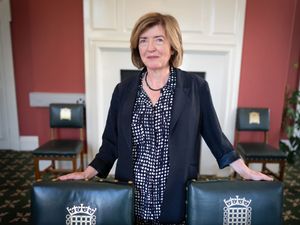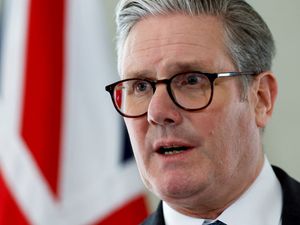New record high number of children in poverty in UK
The latest figure is the highest since comparable records began in 2002/03.
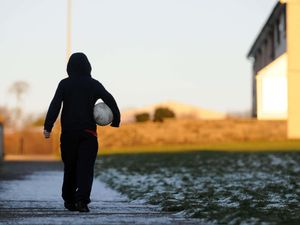
The number of children living in poverty in the UK has reached a record high of almost 4.5 million, in statistics branded “a source of national shame”.
The official figure comes a day after Government estimates suggested welfare cuts will plunge thousands more children below the poverty line by the end of the decade.
There were 4.45 million children estimated to be in households in relative low income, after housing costs, in the year to March 2024, data published by the Department for Work and Pensions (DWP) on Thursday showed.
The latest figure is the highest since comparable records for the UK began in 2002/03.
It rose from an estimated 4.33 million in the year to March 2023.
A household is considered to be in relative poverty if it is below 60% of the median income after housing costs.
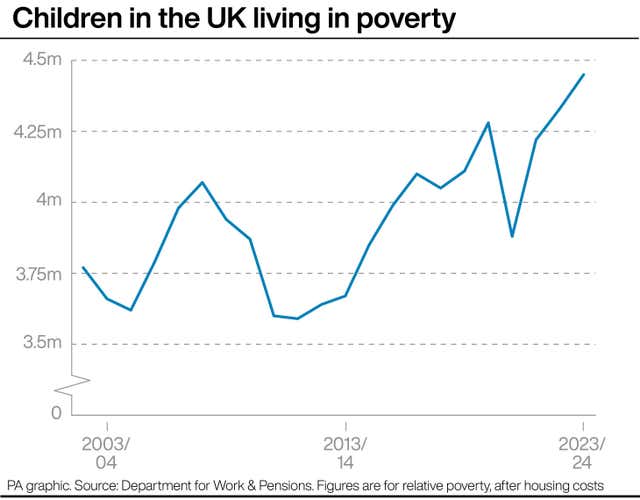
Save the Children warned that, without immediate action, “this could be the first Labour government that oversees a significant rise in child poverty – a record no-one wants”, and described the latest data as “a source of national shame”.
The Government’s own impact assessment, published on Wednesday, estimated welfare reforms could see 250,000 more people, including 50,000 children, fall into poverty by 2029/30.
Charities urged a U-turn on the plans, saying cuts to disability and incapacity benefits announced by the Labour Government will “push more disabled people into poverty and worsen people’s health”.

Chancellor Rachel Reeves has insisted the Government’s plans to support people into work “will result in more people having fulfilling careers paying decent wages and, of course, that’s the best way to lift families out of poverty”.
Anti-poverty campaigners have also repeatedly called for the controversial two-child benefit limit – first announced in 2015 by the Conservatives and in effect since 2017 – to be scrapped.
They have urged plans for the policy – which restricts child tax credit and universal credit to the first two children in most households – to be part of the Government’s child poverty strategy which is due to be published in the spring.
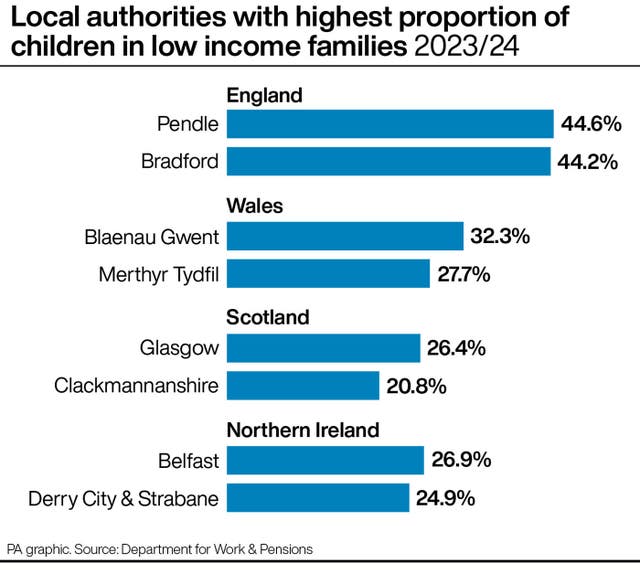
The DWP data also showed that more than a quarter (28%) of children in the UK were estimated to be living in material deprivation in 2023/24.
This means some 4.02 million children were estimated to lack access to four or more items or activities such as three meals a day, school trips and a place for homework.
Almost a fifth – 18.0% or 2.62 million – of children in the UK were living in a food insecure household, meaning they faced a risk of, or lack of access to, sufficient, varied food.
This was the highest proportion since data on household food security was first reported in 2019/20.
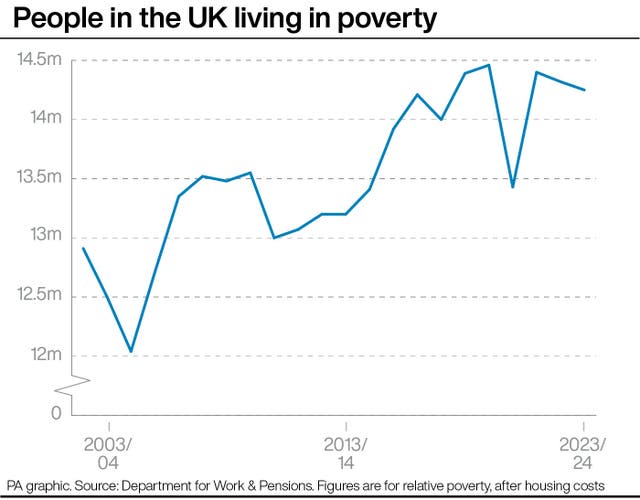
The data on material deprivation is not comparable to previous figures, due to an updated set of questions.
The End Child Poverty coalition said the latest data, which covers a period before Labour came to power, should be seen as a “stark warning” to Government that action is needed, adding that record high numbers of children in poverty “isn’t the change people voted for”.
Oxfam said the figures, showing 30.5% of children in the UK are in poverty, up slightly from 29.9%, are “as damning as they are heartbreaking”.
The charity’s domestic poverty lead, Dr Silvia Galandini, said: “Almost one in three children are living in poverty across the UK. This is before yesterday’s brutal cuts, where the Chancellor chose to remove vital security and safety from those who need it the most instead of taxing the super-rich.”
She described it as “morally repugnant that children, disabled people and carers are the ones who are taking the hit”, adding that it is “unconscionable that the Government is cutting social security while wilfully ignoring the huge potential revenue of a tiny tax on the super-rich, one that is overwhelmingly backed by the British public”.
Work and pensions minister Sir Stephen Timms told MPs in the Commons on Thursday the latest figures “show just what a huge challenge” the “very high level of child poverty that’s left by the previous government” is for Labour but vowed “we’re going to be addressing that”.
Polling for the charity Parentkind, published earlier this week, found one in 10 UK parents living in poverty surveyed said their child had been bullied for being poor, a finding the organisation said showed the “devastating impact” financial struggles can have on families.
Big Issue founder and crossbench peer Lord John Bird said the taskforce established last year by the Government to tackle child poverty must “expedite its long-promised strategy and urge the Chancellor to back its recommendations with real resource and finance”.
Meanwhile, the DWP data showed the total number of people in the UK estimated to be living in poverty was down slightly, to 14.25 million in 2023/24, from 14.32 million in the previous 12 months.
The figure stood at a record 14.46 million in 2019/20.
Some 7.91 million working-age adults were estimated to be in households in relative low income after housing costs in 2023/24, down from 8.11 million in 2022/23.
There were also an estimated 1.89 million pensioners in households meeting this definition for poverty, broadly unchanged on 1.88 million in the previous 12 months.

